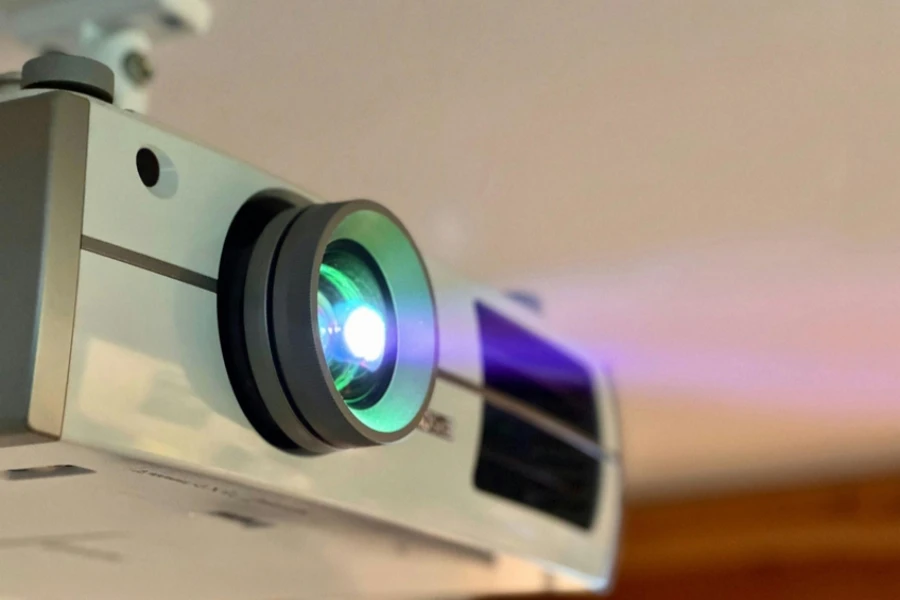Understanding the latest trends in projector technology is crucial for professional buyers aiming to make informed purchasing decisions. With rapid advancements like ultra short throw and laser projection, the market is constantly evolving, making it essential to stay updated.
This article offers a detailed analysis of current market dynamics, key technological innovations, and top-performing models. By exploring these insights, buyers can better navigate the complexities of the projector market and choose the solutions that best meet their business needs.
Table of Contents
● Market Overview
● Key Technology and Design Innovations
● Top-Selling Models Driving Market Trends
● Conclusion
Market Overview

Projector market growth trends
The global projector market is experiencing steady growth, with its size projected to expand from USD 16.24 billion in 2024 to USD 21.74 billion by 2031, reflecting a compound annual growth rate (CAGR) of 3.8%.
This growth is largely fueled by increasing demand across various sectors, including education, corporate, and home entertainment. The rising adoption of advanced projection technologies, such as digital light processing (DLP) and liquid crystal display (LCD), is enhancing the quality and functionality of projectors, making them more appealing to a broader range of users.
Regional dynamics and sector performance
North America dominates the global projector market, driven by substantial investments in cutting-edge technologies, particularly within the education sector. The U.S. remains at the forefront, continuously pushing technological boundaries, which, in turn, boosts projector adoption in classrooms and corporate environments.
Meanwhile, Europe is witnessing a surge in demand for digital workspace solutions and bring-your-own-device (BYOD) programs, further contributing to the market’s growth. Additionally, the Asia-Pacific region is expected to see significant market expansion due to increasing consumer demand for home entertainment systems and the rapid digitization of educational institutions.
Key technology and design innovations

Advancements in projection technology: from DLP to laser
The transition from traditional lamp-based projectors to DLP (Digital Light Processing) and LCD (Liquid Crystal Display) technologies has significantly enhanced projector performance. DLP projectors utilize a chip with microscopic mirrors that rapidly switch to reflect light, resulting in sharp images and high contrast ratios. In contrast, LCD projectors employ liquid crystal cells that alter their reflectivity to control pixel illumination, offering vibrant color reproduction.
However, the introduction of laser projectors marks a significant leap forward. These projectors use laser diodes as the light source, which not only provides up to 20,000 hours of operational life but also delivers brightness levels exceeding 5,000 lumens with superior color accuracy. Laser technology also eliminates the need for bulb replacements, reducing maintenance and operational costs, making them ideal for continuous use in both commercial and residential environments.
The rise of ultra short throw projectors
Ultra Short Throw (UST) projectors are revolutionizing space-constrained environments by allowing large image projection from a very short distance, often within a few inches from the screen. For example, a UST projector can produce a 100-inch display from just 10 to 14 inches away, eliminating the need for complex mounting solutions and extensive cable management. These projectors use advanced optics to focus and control the light path, enabling them to function effectively even in rooms with ambient light.

When combined with ambient light rejecting (ALR) screens, UST projectors can achieve a contrast ratio that competes with traditional setups, making them ideal for home theaters or small meeting spaces. The growing consumer demand for hassle-free, good quality viewing experiences in versatile environments is driving the rapid adoption of UST technology.
HDR and beyond: enhancing image quality
High Dynamic Range (HDR) technology is a game-changer in the projector industry, enhancing image quality by expanding the range of contrast and color accuracy. HDR allows projectors to display images with greater depth, particularly in scenes with significant contrast between bright and dark areas. Technical advancements like Auto Tone Mapping ensure that HDR content is displayed with optimal brightness and contrast, adjusting the image in real-time based on the scene.
Additionally, support for Hybrid Log Gamma (HLG), a standard used for broadcast HDR content, enables projectors to handle live and streaming content more effectively. HDR technology, combined with a wide color gamut and improved color processing algorithms, allows projectors to produce images that are not only brighter but also more true-to-life, with color depth that closely mimics what the human eye can perceive.
Top-selling models driving market trends

Portable powerhouses: compact models with big performance
Among the top-selling models, portable projectors have captured significant attention due to their versatility and convenience. One standout is the Anker Nebula Capsule II, a soda-can-sized projector with 720p resolution and 200 ANSI lumens of brightness. Despite its compact size, it comes equipped with Android TV, offering access to thousands of apps and streaming services directly from the device. The built-in 8-watt speaker and 4-hour battery life make it ideal for on-the-go entertainment, whether at home or on outdoor adventures.
Another popular model is the LG PF50KA, which features 1080p resolution and 600 ANSI lumens of brightness, providing a sharper image than many other portable options. It includes built-in Wi-Fi and a TV tuner, making it a versatile choice for both streaming and live television. The PF50KA also supports screen mirroring from smartphones and laptops, enhancing its functionality in various settings.
Home theater giants: ultimate cinematic experiences
In the home theater category, models like the Epson Home Cinema 5050UB have become best-sellers due to their exceptional performance. This projector offers 4K enhancement technology that shifts pixels diagonally to double the resolution, providing a stunningly detailed image. With 2,600 lumens of brightness and HDR10 support, it delivers vibrant colors and deep blacks, making it a favorite for home cinema enthusiasts. The 5050UB also features motorized lens shift, zoom, and focus, allowing for precise adjustments and easier installation.
Another leader in this space is the Sony VPL-VW295ES, a true 4K projector with 1,500 lumens of brightness. It’s equipped with Sony’s Advanced Reality Creation technology, which enhances image quality by reducing noise and sharpening details. This model also supports HDR10 and HLG, ensuring compatibility with the latest high-definition content. Its superior lens and precise color reproduction make it an ideal choice for creating a cinematic experience in any home theater setup.

Business and education champions: top projectors for professionals
For professional settings, the Optoma EH412 is a top choice, delivering 1080p resolution and 4,500 lumens of brightness, making it ideal for presentations in bright conference rooms. It includes HDMI, VGA, and USB ports for easy connectivity, and its 15,000:1 contrast ratio ensures clear, detailed images even in challenging lighting conditions. The EH412’s 16-watt speaker is powerful enough to fill large rooms, reducing the need for external audio systems.
The BenQ MW560 is another best-seller, particularly in educational environments. It features WXGA resolution (1280×800) and 4,000 lumens of brightness, providing a clear and vibrant display in classrooms. The MW560’s SmartEco mode adjusts the lamp power to maximize energy savings while extending the lamp life to up to 15,000 hours. Its dual HDMI inputs allow for quick switching between devices, making it an efficient tool for educators.
Conclusion
The projector market is evolving rapidly, with technological advancements and diverse model offerings catering to various needs. From portable options that offer convenience and flexibility to high-end home theater models that deliver an immersive cinematic experience, and professional-grade projectors that excel in business and education settings, the market is poised for continued growth. Staying informed about these developments is essential for making strategic purchasing decisions that align with both current trends and future demands.




